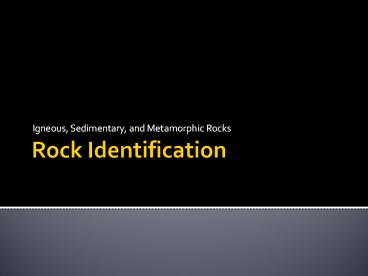Rock Identification - PowerPoint PPT Presentation
1 / 11
Title:
Rock Identification
Description:
Igneous, Sedimentary, and Metamorphic Rocks Solidified products of once-molten material called magma Interlocking arrangement of mineral crystals that forms as the ... – PowerPoint PPT presentation
Number of Views:62
Avg rating:3.0/5.0
Title: Rock Identification
1
Rock Identification
- Igneous, Sedimentary, and Metamorphic Rocks
2
The Rock Cycle
3
Igneous Rocks
- Solidified products of once-molten material
called magma - Interlocking arrangement of mineral crystals that
forms as the molten material cools and crystals
grow - Intrusive form below the Earths surface
- Extrusive formed at the Earths surface
4
Identifying Igneous Rocks
- The rate of cooling determines the size of the
interlocking crystals. - Slower cooling Larger crystals
- Igneous rocks are identified based on texture.
5
Igneous Textures
- Coarse Grained- Majority of crystals are of a
uniform size and can be seen without
magnification. - Fine Grained- Very small crystals which are
generally not identifiable without magnification.
6
Igneous Textures
- Polyphyritic- Two very contrasting sizes of
crystals caused by magma cooling at two different
rates. - Glassy- No mineral crystals develop because of
very rapid cooling.
7
Igneous Textures
- Fragmented- The rock contains broken, angular
fragments of rocky material produced during an
explosive volcanic eruption.
8
Sedimentary Rocks
- Form at or near Earths surface from the
accumulated products of weathering (sediments) - Lithification transforms the sediment into hard
rock - Can be classified as either detrital rocks or
chemical rocks
9
Detritral Sedimentary Rocks
- Detrital- consists mineral grains or rock
fragments derived form the process of mechanical
weathering. Identification is based on the size
of grain.
10
Chemical Sedimentary Rocks
- Chemical- previously dissolved in water and later
precipitated by either inorganic or organic
processes. Mineral composition is used to
identify.
11
Metamorphic Rocks
- Forms below Earths surface with high
temperatures and pressures. - Rocks are identified by both texture and
composition.































